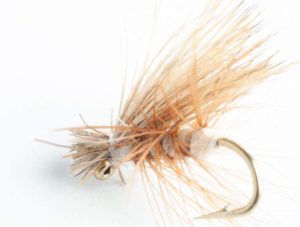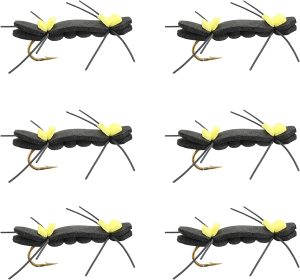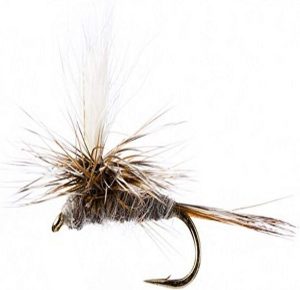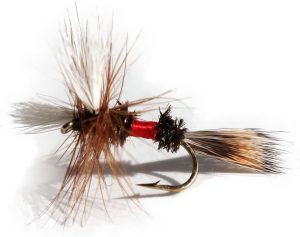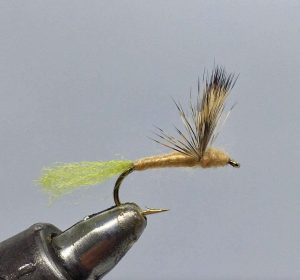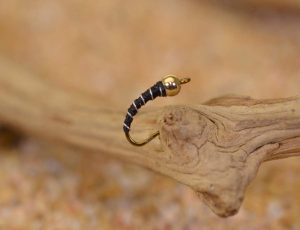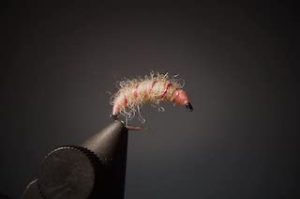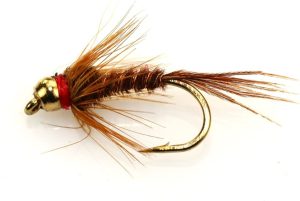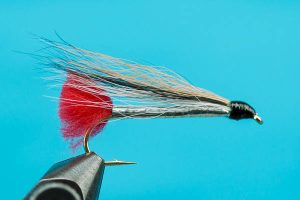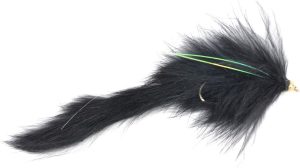When you’re getting ready to go fly fishing, one of the most important choices you’ll make is what flies you’re taking with you. There is a vast variety of fly patterns to choose from, and most of the time when you’re fly fishing, you will want to have at least a few different flies with you. Today, we’re going to share the best of the best– the flies that every fly fisher needs. We break it down by category, and if these flies are in your fly, you have a much better chance of catching fish.
The Essential Dry Flies
Dry flies are are designed to float on the surface of the water. They typically mimic insects that are emerging from their aquatic larval stage or adult insects that have landed on the water’s surface.
Elk Hair Caddis
-
Type: Dry fly
- Imitates: Caddis fly, stonefly
- Typical Size: 10-20
- Other Names: Deer hair caddis
The elk hair caddis was designed by pioneer fly fisher Al Troth in 1957. It has been a popular choice ever since and is one of the most commonly used flies for trout. This one’s a classic for a reason– it’s highly attractive to fish and presents easily. This fly mimics lots of diets across fish in various locations in the world, and therefore, works nearly all over.
Chernobyl Ant
- Imitates: Crickets, ants, grasshoppers, and other terrestrial insects
- Typical Size: 14-10
The Chernobyl Ant was actually first designed to mimic the large black crickets that live around Utah’s Green River. Developed in 1990, the Chernobyl Ant was instantly popular as it mimics high-value meals that fish just can’t resist. This fly uses synthetic materials that float really well, so presentation is easy and you don’t have to worry about your Chernobyl Ant getting pulled under. This is one of the best flies for trout because it can be fished year-round since it mimics several terrestrial insects that can be found all year in many places.
Parachute Adams
- Imitates: Mayfly, midge, flying caddis fly
- Typical Size: 10-18
- Variations: Adams fly
The Parachute Adams is a versatile fly that mimics several different insects. It is a variation of the original Adams fly, which was conceived by Leonard Halladay in 1922 at the request of another fisherman named Charles Adams. While the original Adams fly is still used frequently, the parachute form that has a hackle-tied parachute-style around the wing base is more popular than the original today. This fly is beloved because it mimics three common insects well and the parachute tie helps improve the presentation.
Royal Wulff
- Imitates: several mayfly types, terrestrials, and others
- Typical Size: 8-16
- Variations: Grey Wulff, Brown Wulff, Black Wulff, White Wulff, Blonde Wulff; parachute versions of each of these
The Royal Wulff is a fly with a long history and a unique vibrancy. The recipe for this fly pattern includes peacock herl feathers, so the fly has a beautiful iridescence on the water. The Royal Wulff is descended from the Royal Coachman fly and Lee Wulff’s hair-wing flies that were developed in the 1930s. The Royal Wulff is an attractor pattern that doesn’t mimic any one species in particular; rather, it’s one of the best flies for trout because it has characteristics of lots of insects that the fish just can’t resist.
Sparkle Dun
- Imitates: Several mayfly types, including Pale Morning Duns, Sulphur Mayflies, and Baetis Mayflies
- Typical Size: 14-20
- Variations: Blue-winged olive patterns (BWO)
The Sparkle Dun is a popular BWO variant. BWO flies are a staple of the fly fisher’s fly box because they mimic some of the most common insects found in a trout’s diet. The first mention of the BWO fly patterns was actually in Frederick Halford’s 1897 book Dry Fly Entomology, so there’s a lot of history behind this fly’s popularity! When something works well for over a century, there’s a reason for it. The Sparkle Dun is popular because the iridescent, sparkly material makes it easy to see on the water, and it simply catches a lot of fish.
The Essential Wet Flies: Nymphs
Nymph patterns are usually based on the larval stage of insects, but this isn’t always the case. There are certain nymph patterns that will always attract fish because the animals they are based on are always in the water. This is why you should always have at least a few scud patterns in your fly box because scuds are constantly in the water. Here are some of our favorite nymph patterns.
Zebra Midge
- Imitates: Midges
- Typical Size: 16-28
- Variations: Can be tied in multiple colors, including red and green
The Zebra Midge is a small but mighty fly that works on all types of fly waters. It mimics juvenile midges, which can be found year-round in most water where trout can be found. It’s also an exceptionally easy fly pattern to tie, so if you want to tie your own flies, the Zebra Midge is a great place to start.
Hare’s Ear
- Imitates: Mayfly larvae
- Typical Size: 10-18
- Other Names: Gold-ribbed Hare’s Ear
There are some anglers who only use Hare’s Ear flies. This surefire nymph is easy to tie and easy to use and is great because it can be used year-round. Its colors don’t mimic any specific species of mayfly, and so if there are any larvae at all in the water, fish will go for it.
RS2
- Imitates: midge or mayfly emergers
- Typical Size: 18-28
The RS2 is an emerger pattern that is key for any angler to have in their box. It can be fished anywhere in the water column year round, and is effective in nearly any water that trout live. It is particularly notorious for being effective in tailwater streams. When fishing is slow, this is a go to of many anglers because of its effectiveness.
Killer Bug
- Imitates: Scud, hatching sedge, fish eggs (in small sizes)
- Typical Size: 10-14
One of two Frank Sawyer patterns on our list, the Killer Bug was developed to help control grayling numbers on the River Avon. It has a fascinating history and a number of uses. Smaller Killer Bugs are good for grayling and trout, while larger sizes are good at attracting salmon. This is one of the easiest flies to tie and only uses wool thread and copper wire. Originally the Killer Bug was tied with wool called Chadwick’s 477, but when production of this wool ceased in 1965, Sawyer switched to a specially produced copy. Today, Chadwick’s 477 has a cult following in fly fishing circles, and remnants of the original sell for hundreds of dollars to enthusiasts.
Pheasant Tail
- Imitates: Many nymphs
- Typical Size: 12-20
- Variations: Pheasant Tail Flashback, American Pheasant Tail, Mostly Pheasant, Pheasant Tail Peacock Thorax
Another Frank Sawyer nymph, the Pheasant Tail is a classic pattern that has a broad appeal for trout and other fish. It mimics many different insects that live in trout waters in one fly, so it’s very versatile and can be fished anywhere in any season.
Prince Nymph
- Imitates: stonefly, mayfly larvae, or other nymphs
- Typical Size: 4-18
- Variations: Many, including Rainey’s Prince, Alison’s Purple Wild Thing, Black Jack, Maldonato’s Casino Royale, and Purple Prince Charming
The Prince Nymph is a classic weighted nymph that was first tied by Doug Prince in the 1930s. It was based on the Brown Forked Tail pattern and added a bead head, lead wire, and other innovations to make the fly more appealing to fish. This nymph is an attractor pattern, meaning that it can represent dozens of species of insects, and is often used as a dropper below a dry fly to make a double-fly setup that’s extremely attractive to trout. No matter what kind of fly fishing you like to do, these flies are all great choices. This list is not all-inclusive of the amazing flies out there, but the ones we’ve picked are all versatile and can be fished on many different types of water in many different seasons. These fifteen flies are essential for any fly fisher’s fly box.
The Essential Wet Flies: Streamers
Streamers are a type of wet fly that are used to mimic baitfish, leeches, worms, and other swimming organisms. Streamers can be fished with movement to make them look more realistic, or they can be fished without movement like nymphs are.
Wooly Bugger
- Imitates: Nymphs, baitfish, leeches, drowning terrestrial insects, worms, and small crustaceans
- Typical Size: 2-12
- Variations: Wooly Worm, Palmer Fly; lots of color variations
Often imitated, never duplicated, the Wooly Bugger is an absolute staple fly to have in your kit. It doesn’t look like any specific insect or prey item, and its movement in the water replicates almost anything a trout might want to eat. The Wooly Bugger is one of the classics of the fly-tying world; there are books dedicated to this one fly. You need this one in your box. You can strip it, drift it, swing it, or even twitch it year round with success. The versatility might be unmatched by any other fly in the world.
Black Nosed Dace
- Imitates: Minnows, dace
- Typical Size: 2/0-10
- Variations: Mickey Finn, Little Rainbow Trout
The Black Nosed Dace is a traditional bucktail streamer that’s become quite popular in recent years due to the simplicity in tying it and the effectiveness of the fly. This streamer is great because it looks like many of the most common small fish in trout streams– it’s a generic minnow or dace pattern, so it never looks out of place in the water.
Clouser Deep Minnow
- Imitates: Baitfish
- Typical Size: 2/0-10
- Variations: Freshwater Clouser
The Clouser patterns are quite heavy for flies– so much so that “to clouser” your rod means to lose control over the tip because the fly is so unexpectedly heavy! These streamers act like jigs when pulled through the water and are irresistible to large trout (sometimes). The typical color is chartreuse and white, though different color variations exist for different fish.
Marabou Leech
- Imitates: Leeches and annelids
- Typical Size: 10-4
- Variations: Bunny leech; many color variations
The Marabou Leech is a streamer pattern that’s made using bright, fluffy marabou feathers and is great at attracting fish. While some variants almost resemble baitfish, the most common use of this fly is to mimic leeches, worms, and other soft-bodied organisms that a trout might find delicious.
Muddler Minnow
- Imitates: Minnows, sculpins, crayfish, large insects
- Typical Size: 2-12, up to 3x-4x long
- Buy on Amazon for 4 | Buy On Orvis
The Muddler Minnow was first tied by Don Gapen in 1936, based on the sculpins he saw his First Nations guides capture and use to lure brook trout on the Nipigon River. The Muddler Minnow doesn’t mimic a specific type of baitfish; rather, its mottled appearance and movement mimic a number of terrestrial and aquatic prey items. The Muddler Minnow is the basis for many modern streamers and is a classic found in many fly boxes.
How To Choose A Fly
The first thing you need to think about when choosing your fly patterns is where you’re going to be fishing and what the fish are likely to be eating. Remember, fly fishing is about tricking the fish with the presentation of a fly that mimics what they are naturally eating. Your fly needs to look and act as much like the fish’s natural prey as possible. If it’s the wrong time of year or even the wrong time of day for a specific bug to be out and on the water, the fish are less likely to rise to your fly. So before you pick flies, consult our guide to fly fishing entomology and compare it to what’s happening in your local waters. If you’re not sure exactly what’s going on, it’s always a good idea to check with a local fishing shop– they’ll know exactly what fly patterns are currently working well. It is often recommended that you keep a small, medium, and large example of your favorite patterns in your fly box– that way you’ll always have the right size for the current situation.
Purchasing Quality Trout Flies
There are several ways that anglers can purchase flies:
- Local fly shops – all fly shops will have all of these flies, many variations of these flies, and will be able to help anglers know which flies are currently working. In addition, purchasing from local fly shops supports small business.
- Online fly retailers – there are several online retailers that offer fly purchases in bulk. This is one of the cheapest ways to acquire flies. You’ll often have to pay solid shipping fees unless you make a large enough purchase, but this generally ends up being the least expensive way to purchase flies in the long run. The problem with this is that it is tough to tell the quality of the flies before purchasing them. Big well known retailers like Umpqua, Rio, Orvis, and others will be selling high quality flies, but they tend to be similar pricing to buying at a local fly shop. Amazon also sells flies. Often, the super cheap flies are low quality, and we wouldn’t recommend purchasing. Only go with reputable brands, or retailers that have lots of high quality reviews.
- Online versions of local fly shops. Many local fly shops also allow you to purchase online. This can be a great way to support them while still making the process very convenient.
- Fly packages and assortments. There are several companies that create packages of nymphs, streamers, dry flies, or mixes of them all that are placed in a box and make the purchase process for beginners extremely easy. This often isn’t the most cost effective option, but it gets anglers, particularly beginners, just about every fly they need easily. They can also make really great gifts.
Some of our favorite online retailers for flies:
Rio Products
Trident Fly Fishing
Orvis
The Fly Stop
Discount Flies
Max DesMarais is the founder of hikingandfishing.com. He has a passion for the outdoors and making outdoor education and adventure more accessible. Max is a published author for various outdoor adventure, travel, and marketing websites. He is an experienced hiker, backpacker, fly fisherman, backcountry skier, trail runner, and spends his free time in the outdoors. These adventures allow him to test gear, learn new skills, and experience new places so that he can educate others. Max grew up hiking all around New Hampshire and New England. He became obsessed with the New Hampshire mountains, and the NH 48, where he guided hikes and trail runs in the White Mountains. Since moving out west, Max has continued climbed all of the Colorado 14ers, is always testing gear, learning skills, gaining experience, and building his endurance for outdoor sports. You can read more about his experience here: hikingandfishing/about

